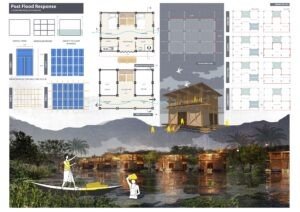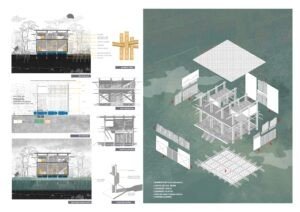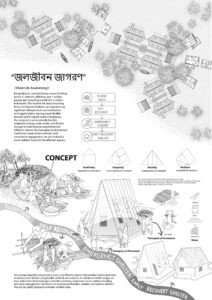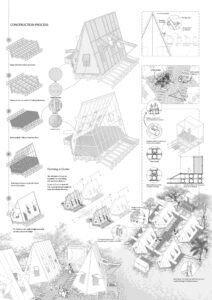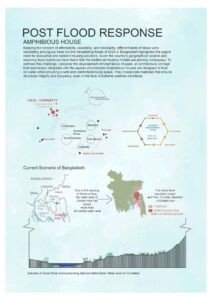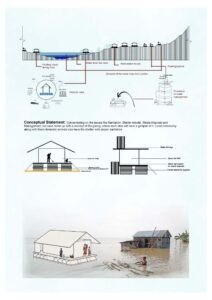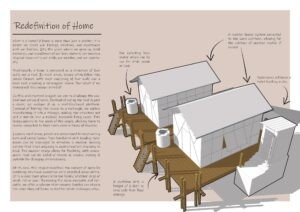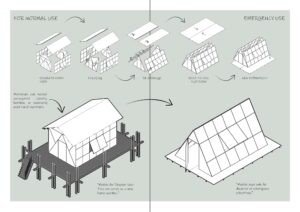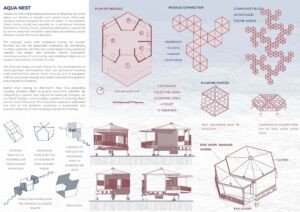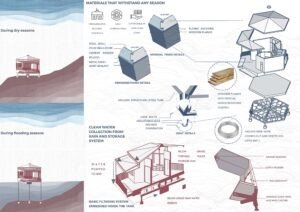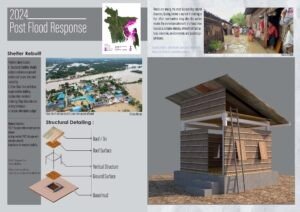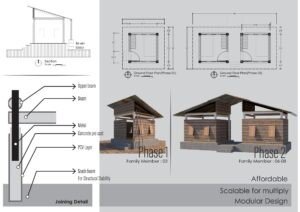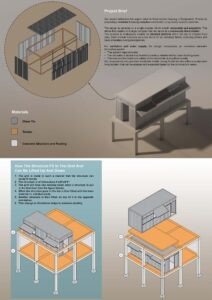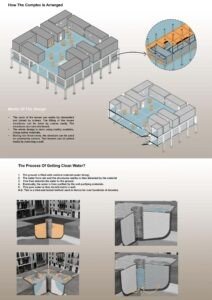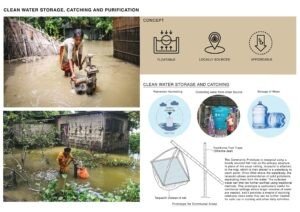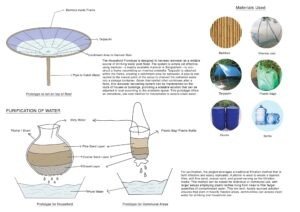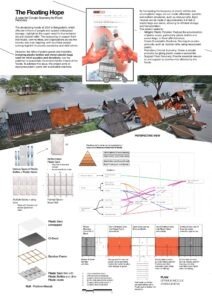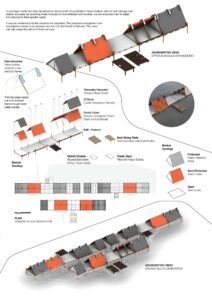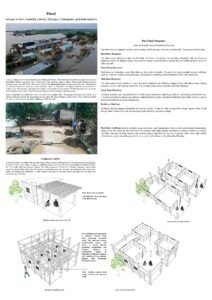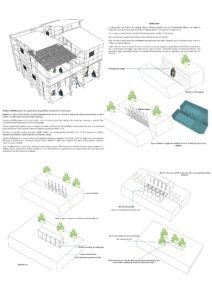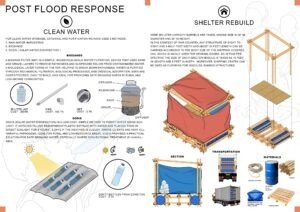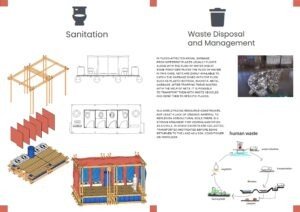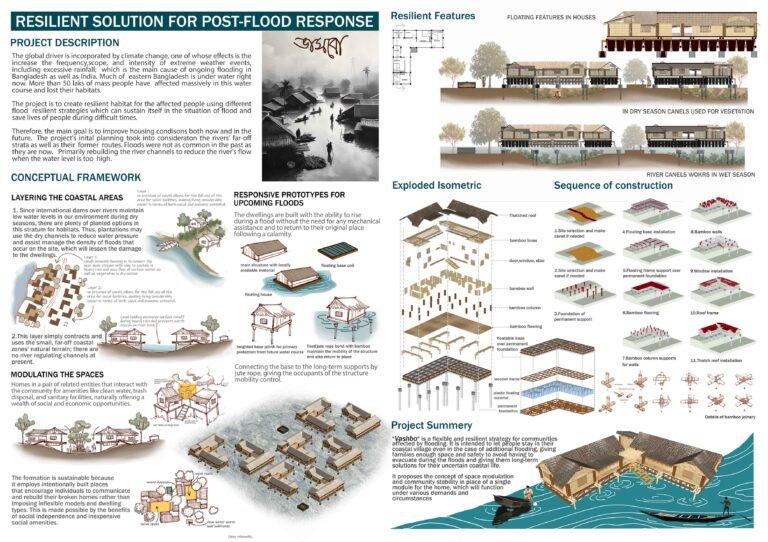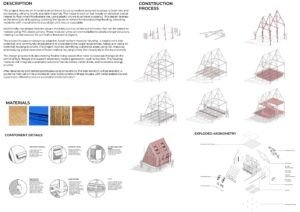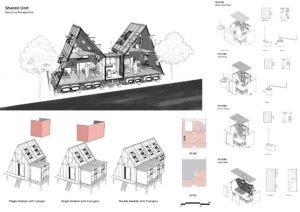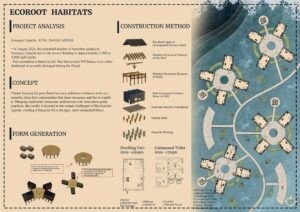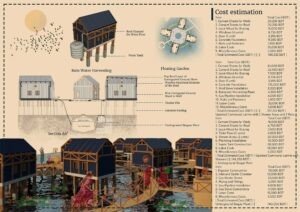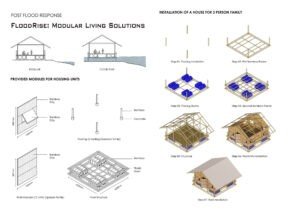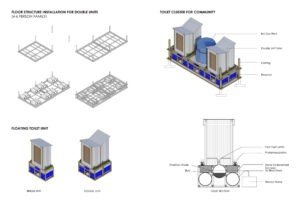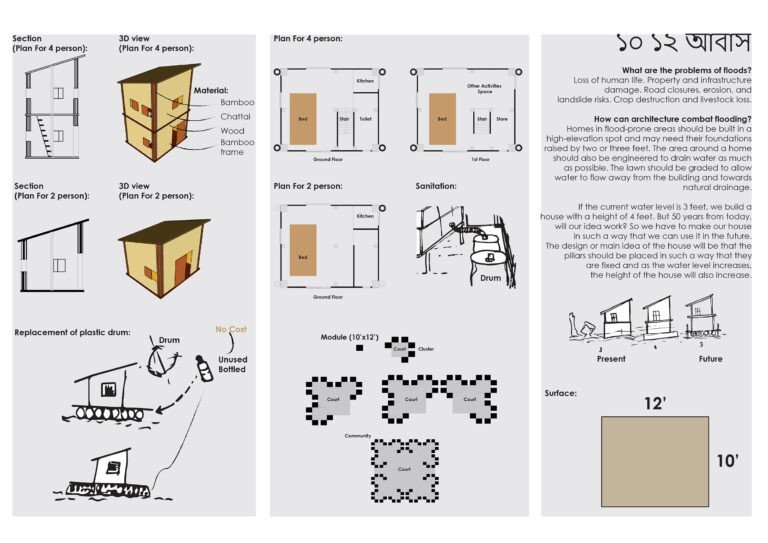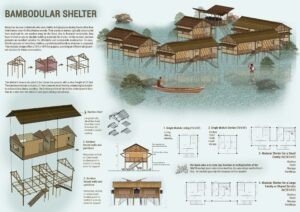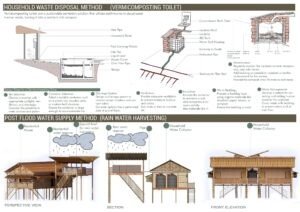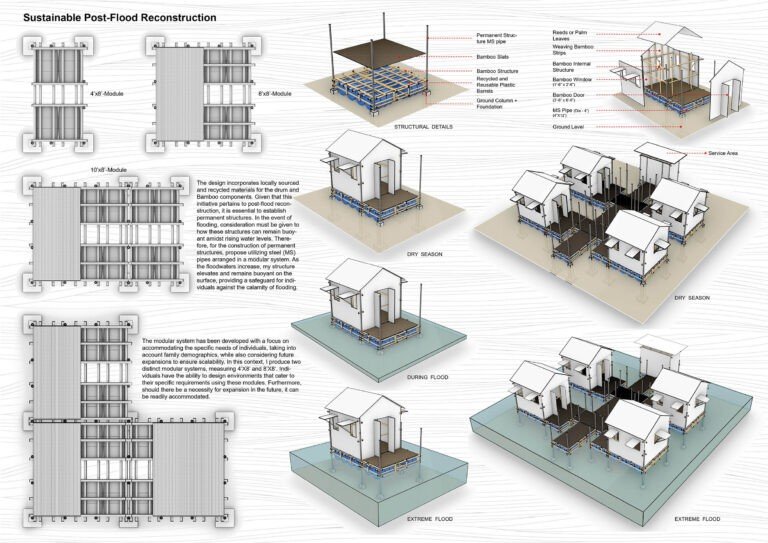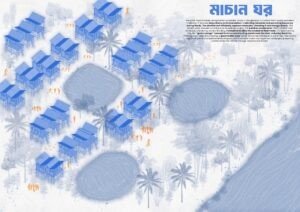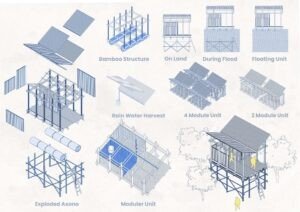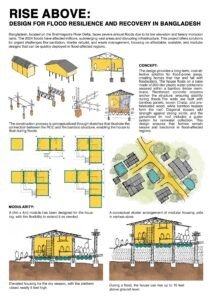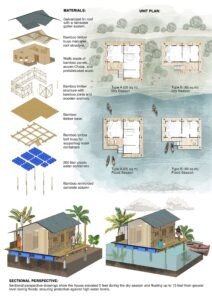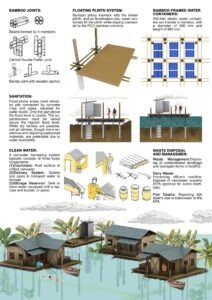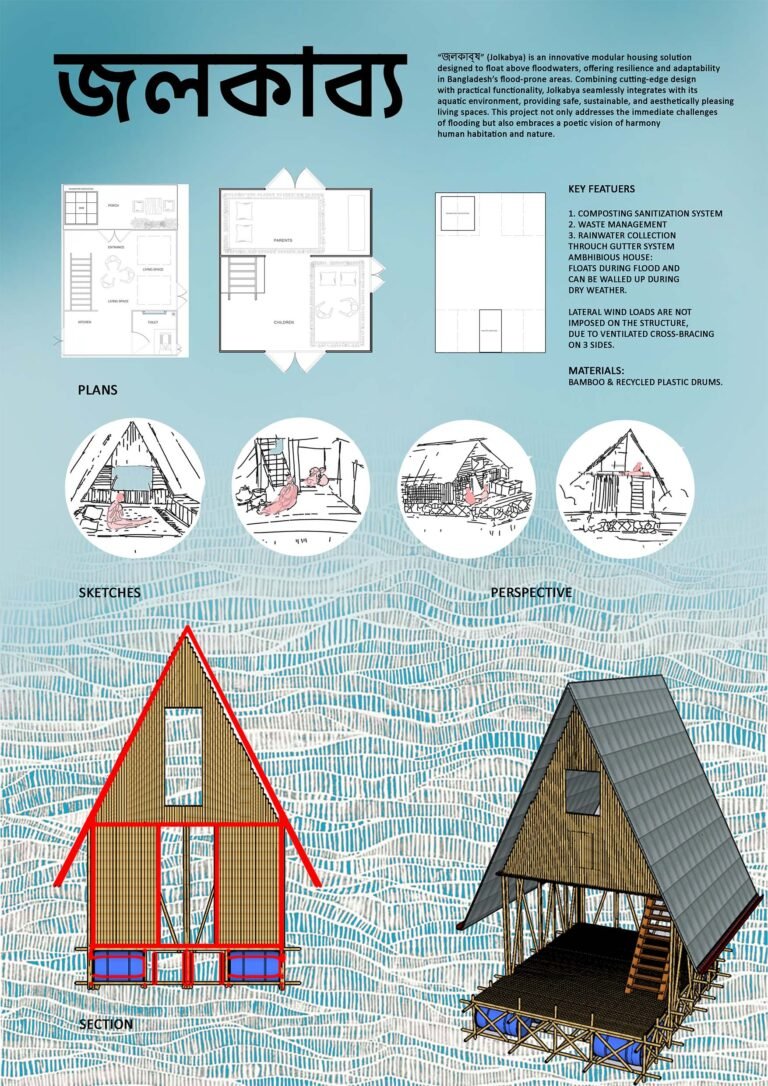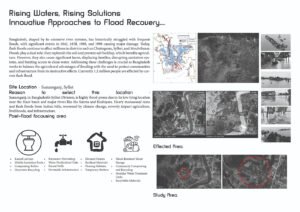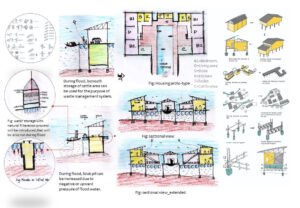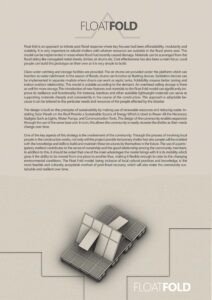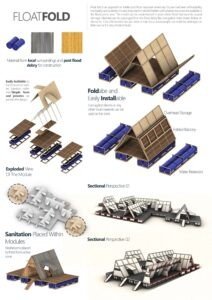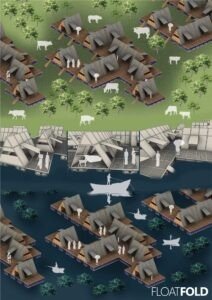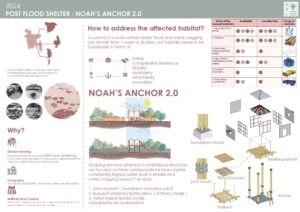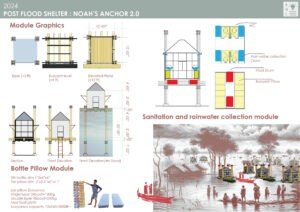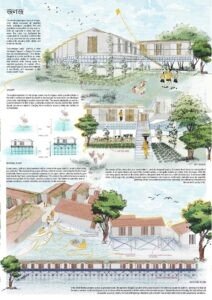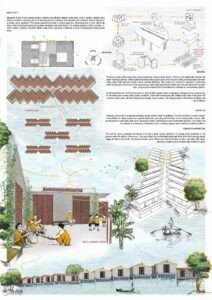Call for Ideas
- Sanitation
- Clean Water
- Shelter Rebuild
- Waste Management
2024 Post Flood Responses
We are thrilled to present the innovative ideas submitted during our recent call for ideas. In just 60 hours, we received more than 30 proposals and have carefully selected 25 exceptional ideas to showcase on our website.
_The submissions are published in the order they have been submitted and not based on any evaluation.
_No further positioning will take place.
_More ideas will be added here if received.
- Sanitation
- Shelter Rebuild
- Waste Management
Mantaka Junnurain Adrito
From Chittagong University of Engineering & Technology
A floating modular housing:
The design focuses on modular housing for post-flood response, prioritizing ease of construction and community needs. Key features include:
- Floating Base: Made from recycled oil barrels, covering 540 sq ft.
- Structural Support: Bamboo and steel piles provide stability, allowing the structure to rise with water levels.
- Sanitation: Connected to underground waste and water tanks.
- Flexible Materials: Side walls can be built with low-cost materials.
- Second Floor: Serves as an emergency shelter with storage.
- Social Spaces: Common areas enhance the community environment.
- Mobility and Cost-Efficiency: Easily movable, using local materials.
- Environmental Considerations: North-south bedrooms and vertical gardens improve the microclimate.
The design is scalable, with detailed plans included.
- Sanitation
- Clean Water
- Shelter Rebuild
- Waste Management
Tasrifa Binte Farazi
Farhan Anjum Bandhan
Syeda Nusrat Tarannum
From Bangladesh University of Engineering & Technology
“জলজীবন জাগরণ”
A proposed shelter design, inspired by traditional local houses, features a triangular shape for stability, using locally available materials like tin, bamboo, and rope. This design allows for rapid assembly and fosters community support through modular clustering. Sustainability is emphasized with the use of recycled materials, aiming for quick, cost-effective solutions that empower local communities. The focus is on scalable, adaptable solutions to aid in both immediate relief and long-term recovery, promoting resilience in disaster-prone regions.
- Shelter Rebuild
- Sanitation
Mehjabin Shahidee Prionti
Md. Taslimul Bari
From University of Asia Pacific
Amphibious House
In response to the 2024 floods in Bangladesh, traditional housing models are inadequate. To address this, I propose Amphibious Houses—floating structures designed to integrate with the aquatic environment. These houses use materials that ensure buoyancy and structural integrity, providing safe and comfortable living spaces even during extreme weather conditions. The design emphasizes affordability, scalability, and modularity.
- Shelter Rebuild
Abdulla All-Noman
Farzana Rahman
From Rajshahi University of Engineering & Technology
Redefinition of Home
The project redefines the concept of home beyond just a physical structure. Traditionally seen as a simple rectangular building with four walls and a roof, this project challenges that notion by envisioning the roof as a multifunctional platform and the structure as a modular, triangular space. The design is adaptable, moveable, and rooted in the emotional connection people have with their homes. By leveraging familiar building techniques in rural areas, the project offers a flexible housing system that grows with families and adapts to changing circumstances, ensuring they can stay connected to their roots even in times of disaster.
- Clean Water
- Shelter Rebuild
Fariha Khondoker
From Bangladesh University of Engineering & Technology
Aqua Nest
Instead of constantly seeking flood solutions, this concept proposes adapting homes to float during floods. These houses rest on reinforced concrete foundations in dry seasons and become buoyant during floods, thanks to a floating mechanism supported by drums beneath a secondary foundation.
The design starts with individual homes but can be expanded modularly, allowing families to connect modules for larger living spaces. Interior courtyards foster community and mutual support during crises. The floating village concept enables well-organized, self-sufficient communities with their own water storage and waste management systems, offering long-term economic benefits. This adaptable housing solution provides a sustainable response to flooding by building resilient communities capable of withstanding flood events.
- Shelter Rebuild
Md. Shamsul Arefin
From Khulna University
Touch the minimum and make it grow
Floods cause severe, long-lasting challenges, including health risks from contaminated water, damaged infrastructure, economic losses, environmental degradation, and psychological trauma. Addressing these requires coordinated efforts for immediate relief and long-term resilience. Structural stability is threatened by muddy, uneven ground, while time constraints and limited equipment complicate construction. Budget constraints and challenges with joining materials like PVC and concrete are also significant issues. Solutions include using PVC pipes with concrete precast columns and grade beams for stability.
- Shelter Rebuild
Md. Asfaquzzaman Rahad
Abu-As-Samad Sojib
Mumtahin Ahmad
From Khulna University of Engineering & Technology
Baksho
BAKSHO is a versatile, rapid-build modular housing system designed for post-flood emergency sheltering. It addresses the need for adaptable housing solutions that can evolve as families grow or their needs change. Instead of offering a single shelter design, BAKSHO provides a system of five pre-defined modules that can be combined in various configurations to suit different occupants and site conditions. These modules are pre-engineered for quick assembly using basic hand tools and unskilled labor, making them ideal for post-disaster scenarios. Built with a timber framework and lightweight wall panels, the design allows for flexible placement of doors and windows, enabling quick, adaptable construction on-site.
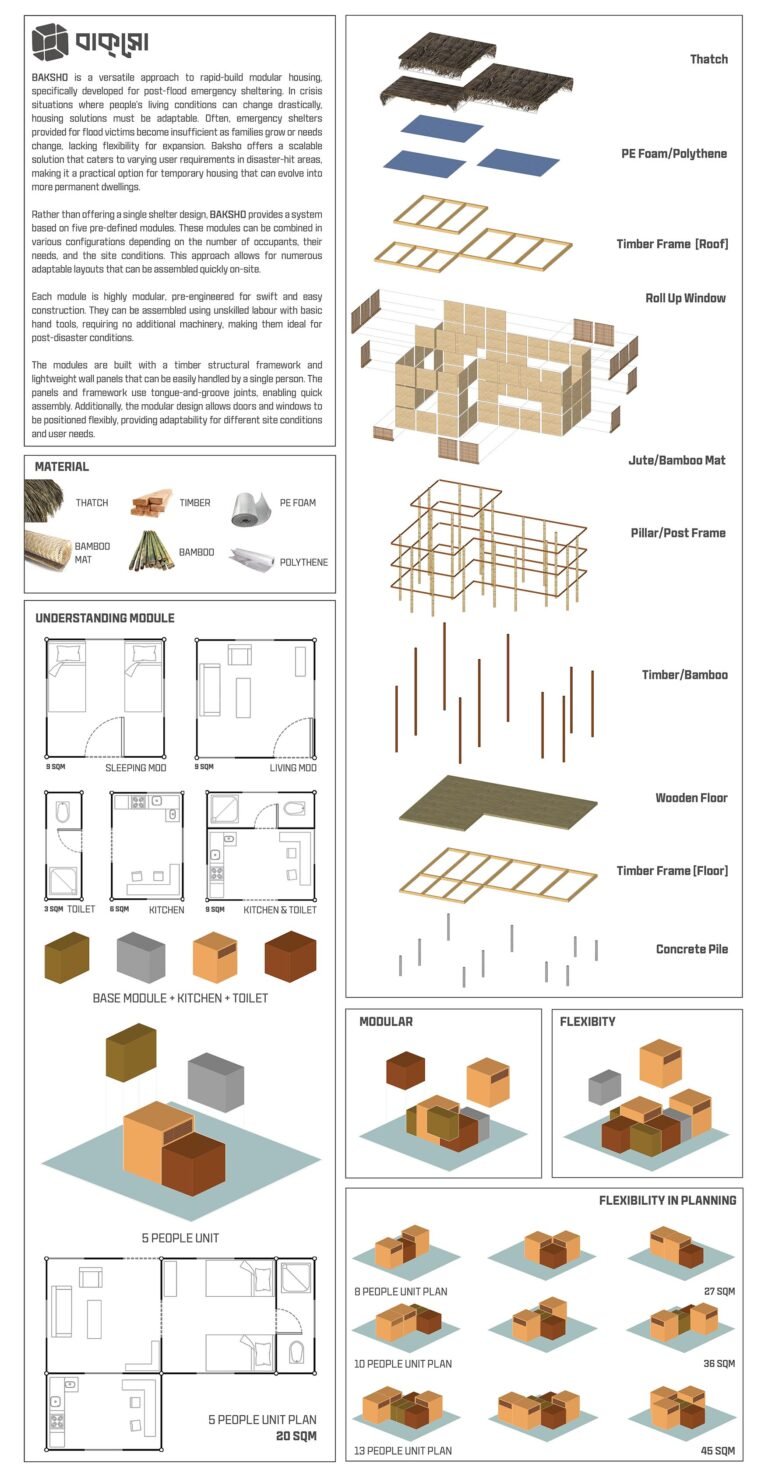
- Clean Water
- Shelter Rebuild
Samia Noushin Sajuti
Bakshi Sameen Easar Sarhan
From Chittagong University of Engineering & Technology
This project addresses the urgent need for flood-resilient housing in Bangladesh by proposing a modular housing complex made from locally sourced materials. The design is based on a single, removable, and adaptable module that can be combined to form a larger community flood shelter. Located on an elevated platform to reduce flood risks, each module functions as a tiny home for individual families, ensuring privacy and basic amenities. The design also includes an innovative rainwater harvesting system for sanitation and water supply, providing clean drinking water during floods. The proposal offers both immediate shelter and a sustainable living solution that can be adapted and expanded as needed.
- Clean Water
Tunisha Kuri
From Bangladesh University of Engineering & Technology
Prototypes that are not only cost-effective but also floatable and made from locally sourced materials, making them accessible to both individual households and communities.
Household Prototype: Uses bamboo and tarpaulin to create a rainwater harvesting system for clean drinking water, adaptable to various sizes and roof spaces.
Community Prototype: Utilizes a fish trap lined with tarpaulin to collect and sediment water, which is then purified for communal use.
Water Purification: Employs a layered filter of sand and gravel in pitchers or plastic bottles for effective water purification.
The project focuses on practical, locally sourced solutions to ensure access to clean water during floods.
- Shelter Rebuild
- Clean Water
Wasif Ajwad
From Bangladesh University of Engineering & Technology
The Floating Hope
The 2024 floods in Bangladesh underscored the urgent need for disaster relief and humanitarian aid. While the response was inspiring, the influx of plastic goods, like bottles and woven bags, risks increasing environmental damage. This project addresses the issue by repurposing plastic waste into sustainable solutions, such as modular rafts. Using the buoyancy of plastic bottles and bags, the project creates affordable, scalable structures for efficient storage and transportation. It aims to mitigate plastic pollution, develop innovative products, promote a circular economy, and support flood recovery by providing essential resources to affected communities.
- Shelter Rebuild
Tanbir Hasan
Shahariar Islam Sumon
From Dhaka University of Engineering & Technology
The Floating Hope
The 2024 floods in Bangladesh underscored the urgent need for disaster relief and humanitarian aid. While the response was inspiring, the influx of plastic goods, like bottles and woven bags, risks increasing environmental damage. This project addresses the issue by repurposing plastic waste into sustainable solutions, such as modular rafts. Using the buoyancy of plastic bottles and bags, the project creates affordable, scalable structures for efficient storage and transportation. It aims to mitigate plastic pollution, develop innovative products, promote a circular economy, and support flood recovery by providing essential resources to affected communities.
- Sanitation
- Clean Water
- Shelter Rebuild
- Waste Management
Bhuban Kumar Shil
Md Farhanul Islam Khandaker
Mashkura Kafil Tanisha
Audry Dey
Wasika Afrin
From Premier University Chittagong
Matra
For clean water, three methods are used: rainwater harvesting, biosand filters, and solar water disinfection (SODIS).
In shelter rebuilding, 200-liter barrels are used, with shelter modules designed to fit shipping van dimensions—10 feet in length and 8 feet in width. Shipping crates can be used as flooring, and bamboo structures form the frame.
For waste management in flood-affected areas, nets trap floating garbage, such as plastic bottles and metal debris, which is then transported and properly disposed of. Additionally, excreta can be collected, treated, and returned to land as a soil conditioner, supporting sustainable sanitation and agricultural practices.
- Shelter Rebuild
Md. Asfaquzzaman Rahad
Fariha Tasnim Supty
From Khulna University of Engineering & Technology
Vashbo
- Sanitation
- Shelter Rebuild
- Waste Management
Sadia Sabrin Tarannum
From Bangladesh University of Engineering & Technology
This project introduces an amphibious housing module designed for both wet and dry seasons, using local materials. The house is built on stilts but can float during floods with the help of plastic drums for buoyancy. It includes plug-in modules like toilets and kitchens, which can be added using PVC joinery, allowing for expandable and adaptable structures.
The project emphasizes creating flood-resilient modular housing through community engagement, data collection, and GIS mapping. It involves studying global examples of flood-resistant designs and integrating sustainable solutions such as bio-toilets and renewable energy. Prototypes will be tested, and a guideline manual will be provided to assist locals in construction, with initial support to ensure effective implementation.
- Clean Water
- Shelter Rebuild
- Waste Management
Tasfia Farhat
Saima Afia Roja
Farhina Khan Karabi
From Khulna University of Engineering & Technology
Ecoroot habitats
In flood-prone Sonagazi, Bangladesh, ECOROOT HABITATS introduces flood-resilient housing with circular platform clusters for efficient living and community interaction. The design includes:
- Floating Gardens: Use rafts with local materials for crop growth during floods, enhancing food security and sustainability.
- Rainwater Harvesting: Captures and stores rainwater for agricultural and domestic use.
- Underground Biogas Plant: Converts waste into biogas for cooking, supporting sustainable waste management.
This approach combines adaptable housing, sustainable agriculture, clean water storage, and waste management to improve flood resilience.
- Sanitation
- Clean Water
- Shelter Rebuild
- Waste Management
Ishrat Rafia
Md. Abdullah Al Mahfuz Mahi
From Bangladesh University of Engineering & Technology
Flood Rise: Modular Living Solutions
In response to rapid flooding and loss of belongings, the proposed amphibian house is designed to float and adapt during floods using inexpensive materials. Key features include:
- Modular Structure: A 4.5m x 4.5m module for 3-4 people, expandable for larger families.
- Floating Base: Bamboo columns and drum-based frames provide buoyancy and stability.
- Construction Materials: Light bamboo for the structure, bamboo chatai for walls, and tin for the roof.
- Mobility: The house can float and be relocated like a boat if necessary.
- Water and Sanitation: Includes rainwater harvesting, amphibian toilets with phytoremediation, and optional floating drum biogas plants for waste-to-energy conversion.
This design aims to offer flexible, resilient housing solutions that can adapt to the increasing frequency of floods due to global warming and rising sea levels.
- Shelter Rebuild
Abdullah Al Mamun
Sadia Afrin
Hussain Md. Shourov Shah
From Pabna University of Science and Technology
To combat flooding, architecture can incorporate several strategies:
- Elevation: Build homes on high ground and raise foundations by two or three feet.
- Water Drainage: Design the surrounding area to direct water away from the building. This includes grading the lawn to enhance natural drainage.
- Future-Proofing: Construct homes with adjustable pillars that can be elevated as water levels rise over time, ensuring long-term adaptability and resilience against flooding.
- Sanitation
- Clean Water
- Shelter Rebuild
- Waste Management
Fardin Islam
Raktim Biswas
From Khulna University of Engineering & Technology
Bambodular Shelter
Bamboo offers a cost-effective, sustainable solution for low-income flood victims. A prefabricated bamboo shelter, measuring 16 ft x 16 ft and elevated 6 feet above ground, provides durable and adaptable housing. It includes a 10-foot clear height, a concrete mesh footing for damp-proofing, and a lower section that serves as a mini barn. The design features a bamboo roof to prevent leaks and sturdy bamboo panel walls.
- Shelter Rebuild
Tasnim Rahman Khan
From University of Asia Pacific
Sustainable Post-Flood Reconstruction
A project in Bangladesh addresses post-flood needs with:
- Sanitation: Modular units made of bamboo and reed, using plastic barrels for waste, offering easy setup and environmental benefits.
- Shelter: Lightweight, durable bamboo shelters with a floating mechanism to adapt to rising floodwaters.
- Waste Management: Floating waste collection units using plastic barrels to manage waste and prevent contamination.
The solutions are affordable, scalable, and rapidly deployable, using local materials for sustainability and quick adaptation to flood conditions.
- Clean Water
- Shelter Rebuild
Fardin Hasan
Fatiha Tanjim Oni
From Chittagong University of Engineering and Technology & BRAC University (Respectively)
মাচান ঘর
Modular Floating Structure: Quick to assemble, made from local materials, with drums for rainwater collection and waste storage. The design allows it to float during floods.
Rainwater Management: Slanted roof captures rainwater for future use. Bamboo exoskeleton supports the structure and can detach to float freely if needed.
Green Sponge: Ponds in front yards capture excess rainwater to reduce flood risk.
Green Buffer: Planting trees and creating vegetative buffers around rivers to absorb water, stabilize soil, and reduce erosion.
This approach blends traditional and innovative methods for effective flood management.
- Sanitation
- Clean Water
- Shelter Rebuild
- Waste Management
Md Rifat Mahmud
S.M Tahasin Hossain Tain
Abu-As-Samad Sojib
From Khulna University of Engineering and Technology
Floating Housing: Houses on plastic water containers and bamboo, designed to rise with floodwaters. Includes bamboo walls, trusses, and a rainwater collection system.
Modular Design: 4×4 meter units can be extended and elevated up to 15 feet during floods.
Sanitation: Features rainwater harvesting and elevated pits for flood-prone areas, with wet latrines preferred.
Waste Management: Proper disposal of contaminated materials and dairy waste, with EPA-approved methods for fish deaths and blackwater issues.
The solutions aim to improve resilience and recovery in flood-affected communities.
- Shelter Rebuild
Nashrat Nur
Anika Tahsin Mouri
Fairuz Ananti
From Chittagong University of Engineering and Technology
Jolkabya is a modular housing solution designed to float above floodwaters in Bangladesh. It features:
- Composting Sanitation System
- Waste Management
- Rainwater Collection with a Gutter System
- Amphibious Design: Floats during floods and can be walled up during dry weather.
- Ventilated Cross-Bracing: Reduces lateral wind loads.
- Materials: Made from bamboo and recycled plastic drums.
The design emphasizes resilience, adaptability, and harmony with the natural environment.
- Shelter Rebuild
Tania Akter
Asa Khatun
Erfan Hasan
From Dhaka University of Engineering and Technology
Rising Waters, Rising Solutions
Bangladesh faces severe flooding due to its river systems, impacting millions annually. Recent floods have affected 1.2 million people, causing displacement, sanitation issues, and limited clean water access.
Site Location: Sunamganj, Sylhet
- Reason: Prone to flooding from heavy rains and river overflow.
Post-Flood Focus Areas:
- Sanitation: Raised latrines, mobile units, composting toilets.
- Water Management: Rainwater harvesting, purification, greywater recycling.
- Infrastructure: Elevated homes, permeable surfaces, flood-resistant materials.
- Waste Management: Floating habitats, community composting, modular treatment units.
- Shelter Rebuild
Md Ashfak Nahin Chowdhury Mugdho
From Bangladesh University of Engineering and Technology
Float Fold
Float Fold is a post-flood response model emphasizing affordability, modularity, and scalability. Key features include:
- Resource Use: Rebuilds shelters using locally available materials from flood debris, like corrugated metal sheets and timber.
- Cost-Effective and Simple: Easy for locals to construct with minimal resources.
- Water and Sanitation: Incorporates air drums for water catchment and floating, and separate modules for sanitation using drums as septic tanks.
- Scalable: Adaptable to demand and expandable with additional features like bamboo supports and solar panels for sustainable energy.
- Community Involvement: Engages locals in construction, providing skills for future maintenance and fostering community ownership.
- Mobility: The design allows for relocation and adapts to changing conditions, making it culturally acceptable and sustainable.
- Sanitation
- Clean Water
- Shelter Rebuild
- Waste Management
Ashfaqur Rahman Chowdhury
Sheikh Shihabur Rahman
Nafis Fuad Khan
Shahriyar Ahmod
Chandan Dewan
Tandra Chowdhury
Resilient Habitat Lab
Noah’s Anchor 2.0 is a conceptual design for a flood-adaptive micro shelter developed by the Resilient Habitat Lab. Key features include:
- Floating Materials: Utilizes bottle pillows for buoyancy.
- Modular Anchor: Ensures stability by restricting movement to the vertical axis.
- Sanitation and Water Systems: Includes modular sanitation and safe water systems.
- Materials: Uses locally available bamboo, tin, and prefab joints.
The design is based on insights from flood-resilient practices and aims to provide safe refuge during floods. However, it remains theoretical and has not yet been tested in real-world conditions. Future work will focus on addressing challenges such as material durability and community acceptance, with further research and testing needed to validate and refine the concept.
- Sanitation
- Clean Water
- Shelter Rebuild
- Waste Management
Mubasshira Maahjabeen Lamya
From Military Institute of Science and Technology
Jalaja (জলজ)
- Purpose: Jalaja is a flood-resilient, floating shelter for flood-prone areas in Bangladesh.
- Materials: Built from recycled plastic, making it lightweight, water-resistant, and eco-friendly.
- Height Adjustment: Extendable columns allow it to rise and float with floodwaters, ensuring stability.
- Sanitation & Water: Includes a waste containment unit and rainwater harvesting for hygiene and clean water.
- Livelihood Support: Has designated areas for livestock and gardening to support food security.
- Community Spaces: Shared areas foster community resilience and support group activities.
- Cost-Effective & Modular: Affordable, scalable design that can expand with family needs.

